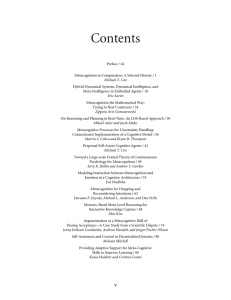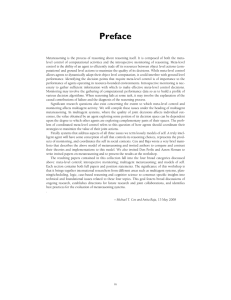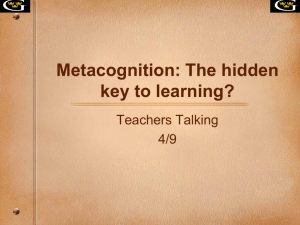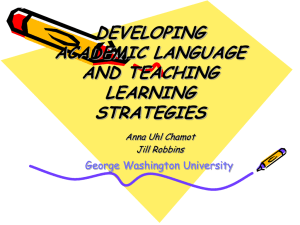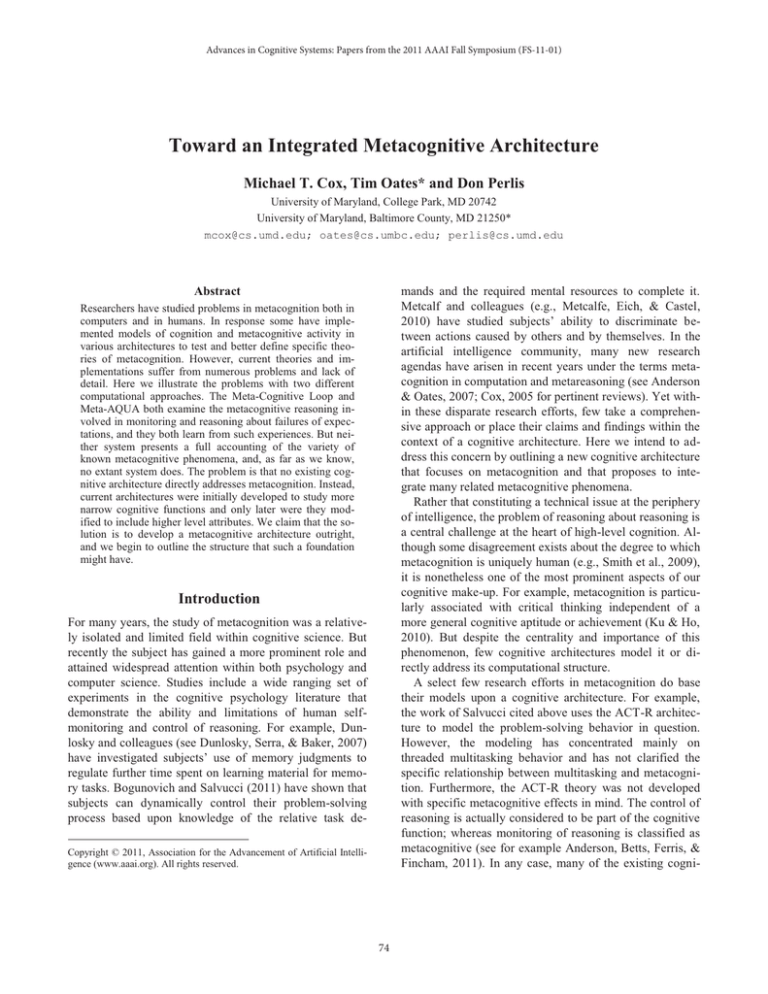
Advances in Cognitive Systems: Papers from the 2011 AAAI Fall Symposium (FS-11-01)
Toward an Integrated Metacognitive Architecture
Michael T. Cox, Tim Oates* and Don Perlis
University of Maryland, College Park, MD 20742
University of Maryland, Baltimore County, MD 21250*
mcox@cs.umd.edu; oates@cs.umbc.edu; perlis@cs.umd.edu
mands and the required mental resources to complete it.
Metcalf and colleagues (e.g., Metcalfe, Eich, & Castel,
2010) have studied subjects’ ability to discriminate between actions caused by others and by themselves. In the
artificial intelligence community, many new research
agendas have arisen in recent years under the terms metacognition in computation and metareasoning (see Anderson
& Oates, 2007; Cox, 2005 for pertinent reviews). Yet within these disparate research efforts, few take a comprehensive approach or place their claims and findings within the
context of a cognitive architecture. Here we intend to address this concern by outlining a new cognitive architecture
that focuses on metacognition and that proposes to integrate many related metacognitive phenomena.
Rather that constituting a technical issue at the periphery
of intelligence, the problem of reasoning about reasoning is
a central challenge at the heart of high-level cognition. Although some disagreement exists about the degree to which
metacognition is uniquely human (e.g., Smith et al., 2009),
it is nonetheless one of the most prominent aspects of our
cognitive make-up. For example, metacognition is particularly associated with critical thinking independent of a
more general cognitive aptitude or achievement (Ku & Ho,
2010). But despite the centrality and importance of this
phenomenon, few cognitive architectures model it or directly address its computational structure.
A select few research efforts in metacognition do base
their models upon a cognitive architecture. For example,
the work of Salvucci cited above uses the ACT-R architecture to model the problem-solving behavior in question.
However, the modeling has concentrated mainly on
threaded multitasking behavior and has not clarified the
specific relationship between multitasking and metacognition. Furthermore, the ACT-R theory was not developed
with specific metacognitive effects in mind. The control of
reasoning is actually considered to be part of the cognitive
function; whereas monitoring of reasoning is classified as
metacognitive (see for example Anderson, Betts, Ferris, &
Fincham, 2011). In any case, many of the existing cogni-
Abstract
Researchers have studied problems in metacognition both in
computers and in humans. In response some have implemented models of cognition and metacognitive activity in
various architectures to test and better define specific theories of metacognition. However, current theories and implementations suffer from numerous problems and lack of
detail. Here we illustrate the problems with two different
computational approaches. The Meta-Cognitive Loop and
Meta-AQUA both examine the metacognitive reasoning involved in monitoring and reasoning about failures of expectations, and they both learn from such experiences. But neither system presents a full accounting of the variety of
known metacognitive phenomena, and, as far as we know,
no extant system does. The problem is that no existing cognitive architecture directly addresses metacognition. Instead,
current architectures were initially developed to study more
narrow cognitive functions and only later were they modified to include higher level attributes. We claim that the solution is to develop a metacognitive architecture outright,
and we begin to outline the structure that such a foundation
might have.
Introduction
For many years, the study of metacognition was a relatively isolated and limited field within cognitive science. But
recently the subject has gained a more prominent role and
attained widespread attention within both psychology and
computer science. Studies include a wide ranging set of
experiments in the cognitive psychology literature that
demonstrate the ability and limitations of human selfmonitoring and control of reasoning. For example, Dunlosky and colleagues (see Dunlosky, Serra, & Baker, 2007)
have investigated subjects’ use of memory judgments to
regulate further time spent on learning material for memory tasks. Bogunovich and Salvucci (2011) have shown that
subjects can dynamically control their problem-solving
process based upon knowledge of the relative task deCopyright © 2011, Association for the Advancement of Artificial Intelligence (www.aaai.org). All rights reserved.
74
ta-level control determines a sequence of mental actions or
otherwise mediates the functioning of the object level. Metareasoning causes the reasoner to think in certain ways as
reasoning causes the agent to act in a certain manner. It is
this duality of reasoning and metareasoning (or of cognition and metacognition) 1 that an integrated architecture
must capture and through its fixed structure enable the
modeling of various tasks both computationally and psychologically.
Note that most existing cognitive architectures concern
the orange areas (i.e., the lighter color if in grey-scale) associated with the action and perception cycle. This paper
will recast this cycle in a new structural and representational framework based on a model by Norman (1986) and
will add the blue colored layer to formulate an analogous
cycle at a higher level. We will introduce this framework
by first considering in the next section two different systems that model metacognitive processes and that share
many aspects. Then in the subsequent section, we will propose a specific new metacognitive-architectural framework. The conclusion will summarize and will suggest an
applied, task domain of self-regulated learning within
which to implement and evaluate our ideas.
tive architectures have limitations when modeling metacognitive activity and have been modified on an as needed
basis to fit the circumstances.
To clarify the problem, let us consider the most basic
mechanisms of high-level reasoning about the self. Metacognition research encompasses studies regarding reasoning about one’s own thinking, memory and the executive
processes that presumably control strategy selection and
processing allocation. Metacognition differs from standard
cognition in that the self is the referent of the processing or
the knowledge (Wellman, 1983). In most interpretations
(e.g., Hayes-Roth, Waterman & Lenat, 1983; Kuokka,
1990; Perlis, 2011), meta-X can be translated to “X about
X:” Thus metaknowledge is knowledge about knowledge,
and metacognition is cognition about cognition. But often
metaknowledge and metamemory (memory about one’s
own memory) are included in the study of metacognition,
because they are important in self-monitoring and other
metacognitive processes. Thus in much of the literature,
the term metacognition is broadly construed to apply to all
self-reflective facets of cognition (Cox, 2005).
Nelson and Narens (1992) first proposed a model of metacognition in humans that divided mental processes into
an object level (cognition) and a meta-level (metacognition) such that the meta-level contains within it a dynamic
model of the object level. Monitoring is the flow of information from the object level to the meta-level, and control
information flows from the meta-level to the object level. It
was Cox (2005) that first noted that this model applies to
computational models of metareasoning as well as to human models of metacognition. Finally Cox & Raja (2011)
extended this model to the one shown in Figure 1.
The relationship between ground and object levels
represents a classical action and perception cycle. Events at
the ground level are perceived as a set of percepts through
some collection of sensors. In response the object level selects some sequence of actions and performs them through
the agent’s effectors. This interacts with and changes the
environment at the ground level, and the cycle continues.
Likewise, the relationship between the object level and the
meta-level is cyclical. Like perception, introspective monitoring is the reception of information that describes the
events and transitions at the object level. In response, me-
Two Current Implementations
Researchers have implemented a number of computational
systems that follow the basic metareasoning model above.
Here we will briefly examine two such implementations
with which the authors have experience. First we consider
the concept and implementation of the Meta-Cognitive
Loop and then the Meta-AQUA system.
The Meta-Cognitive Loop
The MetaCognitive Loop (MCL) (Anderson & Perlis,
2005; Schmill et al., 2011) represents an architecture that
enables a system to reason about itself. Conceptually, MCL
in its current form consists of a module attached to a given
“host” system H (see Figure 2). The host system supplies
information to MCL about its possible actions and their
purposes in the form of general expectations of outcomes
of those actions under various conditions. For instance, the
action “go to location X” might be associated with the expectation “be at location X within ten seconds.” H also
1
In this paper we use metareasoning and metacognition in a roughly synonymous way. We will often use the term metareasoning when referring
to AI aspects and metacognition when referring to human aspects. However we also consider metareasoning to be a more narrow term when considered technically. It means reasoning about reasoning and does not necessarily include related issues such as metaknowledge or reasoning about
other agent’s reasoning. Metacognition on the other hand is used here and
by other authors more generally in a broad sense to include many related
high-level functions such as self-modeling, metalinguistic selfreferencing, knowing what one does not know, and feelings of selfefficacy.
Figure 1. Simple model of metareasoning
75
contains nodes that abstractly describe how a system might
fail. Nodes in the failure ontology represent the underlying
cause of expectation violations. Finally, when hypotheses
about the failure type have been generated, the guide phase
maps that information to its own response ontology, which
describes means for dealing with failures at various levels
of abstraction. Through these three phases, reasoning starts
at the concrete, domain-specific level of expectations, becomes more abstract as MCL moves to the concept of system failures, and then becomes more concrete again as it
selects a specific system response based on the hypothesized failure.
Reasoning from indications to responses is done by
treating the ontologies as a Bayesian network in which all
random variables are Boolean (Schmill et al., 2011). The
random variables in the indications ontology are true if the
corresponding indication has been observed and are false
otherwise. Random variables in the failure network are true
if the corresponding failure has actually occurred and are
false otherwise. This is not directly observable, but standard inference methods make it possible to compute a
probability distribution over these variables based on the
observable evidence (the indications). Finally, random variables in the response ontology are true if the response
will likely repair the underlying failure and are false otherwise. Each response has an associated cost, and again
standard inference methods are used to find the response
with the highest expected utility.
MCL in various versions has been used in a wide variety
of domains, including robot navigation, reinforcement
learning, natural-language human-computer dialog, and
playing an arcade tank-game; see Haidarian et al. (2010)
for an overview and Wright (2011) for technical detail.2
concrete
fringe
abstract
core
supplies MCL with sensor readings, such as “current location” and “time” so that MCL can monitor the success of
H's actions by comparing expectations and outcomes. This
is the first of three steps in MCL's loop: note anomalies
(mismatches between expectations and outcomes).
indications
failures
expectations
MCL
introspective
monitoring
responses
corrections
meta-level
control
host system
Figure 2. The meta-cognitive loop
Once an anomaly is noted, MCL assesses the anomaly in
light of its knowledge about factors such as importance,
likely causes, similarity to other anomalies, and possible
responses (e.g., try again, ask for help, recalibrate sensors,
postpone, give up). Finally, MCL selects – and guides H to
enact – a response based in part on its likelihood of success. Thus MCL is in effect the following algorithm: note;
assess; guide; repeat. Our underlying vision of MCL, then,
is as a module that, when suitably attached to a host system
H, leads dynamically to enhanced performance in the
MCL+H symbiot.
MCL is intended to be a domain-general framework for
autonomously identifying and dealing with anomalous situations. To achieve this goal, MCL must require minimal
domain-dependent engineering and therefore must also be
able to leverage abstract, domain-independent reasoning to
find solutions to problems without burdening the host system designer with the task of specifying how the host
might fail and how to cope with those failures. To allow
for this ability, we have developed three ontologies (see
Figure 2) that support the required classification and reasoning abilities in each of the three MCL phases of note,
assess, and guide. The core of these ontologies contains
abstract and domain-neutral concepts; when an actual
anomaly is detected, MCL attempts to map it onto the
MCL core so that it may reason about it abstractly. Nodes
in the ontologies are linked, expressing relationships between the concepts they represent. There are linkages both
within and between the ontologies, which together allow
MCL to perform abstraction and reasoning about the anomaly being considered.
In our current implementation, each of the three phases
of MCL employs one of the ontologies to do its work. The
note phase uses an ontology of indications, where an indication is a sensory or contextual signifier that the system's
expectations have been violated. Processing in the indication ontology allows the assess phase to map nodes in the
indication ontology to nodes in the failure ontology, which
Meta-AQUA
Meta-AQUA (Cox, 2007; Cox & Ram, 1999) is an implementation of a theory of Introspective Multistrategy Learning (IML) and a cognitive model of introspection. As a
model of goal-driven learning it shares much with the noteassess-guide cycle of MCL. For example they both focus
on responding to failure. However as a model of introspection, many differences exist between the two.
IML theory focuses on the deliberative aspects of learning as opposed to a more unconscious process of reinforcement or operant conditioning. Like the note-assessguide cycle, introspective learning starts when expectations
fail. A contradiction is said to exist when actual observations or outcomes differ significantly from an agent’s expectations. However failure symptoms other than contra2
Among these, the first two (navigation and RL) were not metacognitive
in the strict sense: the implementations did not involve an explicit knowledge base, and the monitoring and control were applied directly to behavior rather than beliefs.
76
diction can also trigger learning. An impasse occurs when
no expected outcome can be generated, and a surprise occurs when there is no expectation and no attempt to generate an expectation. All three of these cases are considered
anomalies or symptoms of failure in IML theory. They are
detected in an identification phase similar to the note step
of the metacognitive loop.
Given a failure symptom, the next phase is to explain the
failure or the underlying cause. Here explanation can be
thought of as a diagnostic symptom to fault mapping and
as such is an instance of self-diagnosis. The explanation
process is considered a generation phase of learning and
corresponds to the assess step in MCL. The task of the
phase is to generate an explanation that bridges the gap
from failure symptom to failure cause. For example the
symptom may have been that a person expects to be correct
when calling a new acquaintance Bill instead of John, and
the cause could be that he confused John with another person he already knew. Thus the contradiction is between the
expectation name=Bill and the observation name=John;
whereas, the causal explanation is that the person forgot
the correct name (i.e., the cues in the context of the utterance were not sufficient to retrieve the name of John, because the storage indexes did not match the retrieval
probe).
The explanation generation phase in IML is a knowledge-rich process. The Bayes net approach in MCL is a
knowledge light approach. The explanations in the former
contain not only the structure of the failure, but they also
identify what possible parts of the structure may be responsible for the failure. For example the name-forgetting explanation may highlight the index of the memory retrieval
as the main causal factor in contradictions of this type.
Along with this identification, the structure will also associate a learning goal with the flawed index. The goal would
be to achieve an index that would have retrieved the correct name given the context. Subsequently a deliberate
learning process would create and execute a plan to
achieve the learning goal. This plan and execute phase corresponds to MCL’s response step.
The performance task of the Meta-AQUA system is story understanding. The system inputs a story in a pre-parsed
conceptual representation, and it outputs a model of the actions and events in the story along with a set of explanations that explain why agents perform particular actions. A
story is understood if the incremental representation of the
story is predictive (i.e., schema instantiations anticipate
subsequent events in the story stream), coherent (i.e., the
graph structure underlying the representation is fully connected), and explanatory (i.e., annotations provide motivational causality for interesting or anomalous events).
As shown in Figure 3, Meta-AQUA contains a number
of major subsystems. At the ground level is a story generation module called Tale-Spin that produces a sequence of
Learning Subsystem
Problem
Generation
Tale
Spin
Story
Input
Multistrategy
Learning
Performance Subsystem
Multistrategy
G
Story
Understanding
CBR
Trace
Introspective
Monitoring
Memory
FK
case
library
XP
Library
Learning
Algorithms
Learning
Algorithm
Toolbox
Story
Representation
Planner
Learning
Goals
XPs
Learning
Plans
script
library
is-a
hierarchy
∆BK
Execute Learning
Meta-level
Control
BK
Figure 3. Meta-AQUA cognitive architecture
stories for Meta-AQUA to understand. The stories are at
the ground level because the performance task at the object
level is to understand events in the story. One could think
of input story concepts as percepts from an imagined environment. The performance subsystem uses knowledge
structures from its background knowledge (BK) to interpret and explain events and to create a representation of the
story in it foreground knowledge (FK). The FK and BK
constitute a memory system for Meta-AQUA.
The Meta-AQUA system implements the IML model as
an introspective version of case-based explanation (see for
example Schank, Kass & Riesbeck, 1994). That is, the
computational problem is to retrieve from a case-base of
introspective meta-explanations (Meta-XPs) an explanation
pattern that partially matches the structure of the current
trace of reasoning representing a given anomaly. The structures are called meta-explanations, because initially they
represented meta-level explanations of object-level explanation failure. The Meta-AQUA program is a model of introspection, because it represents traces of reasoning with
Meta-XPs and allows the system to reason about the prior
reasoning that underlies this representation.
When explanation failure occurs at the object level task
of understanding the story, a trace of the reasoning that
preceded the failure is passed to the learning subsystem.
This trace constitutes a form of introspective monitoring.
The learning component then retrieves an introspective
meta-explanation and binds it to the reason trace. As mentioned above, this instantiated explanation pattern will then
contain a set of learning goals with which a planner can
generate a learning plan. The execution of this plan will
then change memory structures in the BK, thus producing
meta-level control of the object level reasoner. If learning
is successful, similar explanation failures will not reoccur
77
given similar stories in the future. See Cox & Ram (1999)
for further details.
goal change
goal input
goal insertion
subgoal
Goals
Limitations and Gaps
Although both MCL and Meta-AQUA have produced significant contributions, neither system implements a full
metacognitive architecture. They each contain a number of
limitations that prevent them from fully acting as a model
of metacognition.
Although MCL when attached to a host such as a robot
represents an agent embodied in a real world, MCL has a
weak model of perception and no model of high-level understanding and interpretation. Meta-AQUA performs deep
understanding and reasons about the mental states of other
characters, but it is essentially a disembodied agent, lacking a model of action and personal agency. Whereas MetaAQUA has a complex multifaceted memory and reasons
about memory events, MCL does not have a model of
memory or retrieval. However neither agent has an episodic memory to represent cases of personal experience and
individual actions. Despite the lack of work on episodic
memory in the cognitive architecture literature (but see
Nuxoll & Laird, 2007), it has been argued that such autobiographical memory associated with a cognitive and nonverbal self is an important precursor to metacognitive
awareness and the development of children’s theory of
mind (Howe, Courage, & Edison, 2003).
Finally neither MCL nor Meta-AQUA has an explicit
model of self. The systems do not have a model of the contents of their background knowledge for example, and thus
they cannot answer questions such as what kinds of tasks
are they expert at. They have no feelings of confidence as
they perform a cognitive task, and thus they cannot decide
whether or not they are getting close to an answer. Without
such a model the system is severely limited in its ability to
explain itself (Cox, 2011). Instead of adding on these missing attributes to an already existing framework, we claim
that what is required is a principled new architecture that
addresses issues of metacognition from the start.
Intend
Problem
Solving
Memory
Evaluate
Explanation
World Model
Plan
Plans
Interpret
Semantic Memory
Episodic Memory
Act
Visual Memory
(& Speak)
Perceive
(& Listen)
Domain
Figure 4. Norman's (1986) model extended
the goals. Like many cognitive theories, intelligence is organized around an action-perception cycle.
For Norman each part of the cycle contains certain subprocesses. The execution side consists of intention, planning, and then action execution; the evaluation side consists of perception, interpretation, and goal evaluation. The
cycle is to take a goal and commit to achieving it in a general way. The human then plans to achieve the goal and
subsequently executes the planned actions that change the
world, thereby making the goal state so. The evaluation
part of the cycle perceives the changes to the world affected by the actions, interprets the percepts with respect to
the plan, and evaluates the interpretation with respect to the
goal.
The example Norman uses is the goal of having an improved document appearance. Thus a user intends to
change the justification from ragged right to justified using
a word processor. The plan is to select the text body and
then to apply justification formatting. The actions involve a
series of mouse movements and key clicks. These operations change the appearance of the document and the user
perceives the change. The user interprets the percepts with
respect to the plan and then evaluates the document appearance to determine whether the goal is achieved. We
embrace this formulation and propose to extend it with a
number of embellishments.
One of the important factors that Norman neglected in
his model was a role for memory. Many mistakes of reasoning occur due to memory, and it plays a central function
in both cognitive and metacognitive processes. We have
thus included memory in our model and consider all cognitive processes to have access to it. As seen in Figure 4,
memory would contain both semantic and episodic components. Here also would be a model of the current environment, plans, and a visual memory. None of these additions are particularly unique to cognitive architectures, but
they are necessary.
A Dual-Cycle Metacognitive Architecture
Norman (1986) posits a useful model of human-computer
interaction that emphasizes a significant contrast between
two major cognitive systems. For him, complex, human interaction is driven by the twin processes of action execution and goal evaluation (see main orange cycle in Figure
4).3 In the former process, an individual decides to execute
actions to achieve goals, and in the latter, the individual
evaluates how well the change in the environment matches
3
We are not the first to take inspiration from Norman. Lewis (1998) used
the model to more effectively understand various strategies of humanagent interaction.
78
Taken as a whole, Figure 4 represents the object level
and the ground level of a perception-action cycle as shown
in Figure 1. Figure 5 shows a metacognitive reflection of
Figure 4 integrated into a single, dual-cycle architecture.4
Two different ways exist that the meta-level (in blue)
can affect the object level (in orange). First the meta-level
can act as an executive function in a manner similar to
CLARION (Sun, Zhang, & Mathews, 2006). It can decide
Furthermore and like most cognitive theories, Norman’s
treatment of goals is static. That is, goals are simply given;
the model does not account for their genesis. However, as
an innovative claim we contend that they are dynamic objects instead and will change over time. Goals are malleable and are subject to transformation and abandonment
(Cox & Zhang, 2007). Figure 4 illustrates this in the reflexive loop from goals to themselves. Goals also arise from
Goal Management
goal change
goal input
goal insertion
subgoal
Meta Goals
Intend
Evaluate
Memory
Reasoning Trace
Meta-Level
Control
Strategies
Plan
Introspective
Monitoring
Metaknowledge
Self Model
Control
Meta-Level
Interpret
Episodic Memory
Monitor
Mental Domain
goal change
goal input
goal insertion
subgoal
Goals
Object Level
Intend
Problem
Solving
Memory
Evaluate
Explanation
World Model
Plans
Plan
Interpret
Semantic Memory
Episodic Memory
Act
Visual Memory
(& Speak)
Ground Level
Perceive
(& Listen)
Domain
Figure 5. A metacognitive integrated dual-cycle architecture (MIDCA)
traditional sub-goaling on unsatisfied preconditions during
planning (again see Figure 4). Finally new goals arise as
problems are recognized in the environment due to anomalies. The agent recognizes the problem, explains what
causes the problem, and generates a new goal to remove
the cause (Cox, 2007). This type of operation, called goal
insertion, is indicated by the thin, black arrow from the interpretation process in Figure 4.
between object-level parameters, it can allocate resources
between competing object-level processes, and it can set
priorities on object level goals. The kinds of decisions an
executive function may determine are as follows.
4
Note that although memory is shown as separated into two parts, this is
an artifact of the split diagram. For example both the object level and the
meta-level can access episodic memory. There are not two distinct episodic memory stores.
79
• When to switch between cognitive processes.
• When to act at the ground level instead of thinking further.
• When to change goal priorities.
• How resources are distributed between cognitive
processes.
Some early work has been performed on parts of this architecture, but most of this model is in the early stages of
development. The outline here gives a high-level overview
and provides the details for the core of the model.
Another qualitatively different way in which the metalevel can have an effect on the object level is for it to
change the essential structure and content of reasoning.
Given that reasoning is goal-directed processing of an input using specific knowledge (Cox & Ram, 1999), the meta-level reasoner can change either the goals, the processes,
the input, or the knowledge to orchestrate the object level.
Consider changing the knowledge that an agent uses to
make decisions (i.e., learning). As pointed out in an earlier
section, Meta-AQUA receives traces of faulty reasoning
via introspective monitoring. It then interprets the reasoning trace to explain the failure and generate a learning goal.
This goal represents a desired change in its own background knowledge. The system then creates a learning plan
and executes that plan to achieve the learning goal. Subsequently this change to its knowledge affects and indirectly
controls the subsequent performance at the object level in
Meta-AQUA. The above sequence is completely at the meta-level within Figure 5 (c f., Figure 3). For extensive details concerning representations and algorithms implementing this sequence, see Cox & Ram (1999). See Cox (2011)
for a detailed example of the representation used to implement reasoning traces (i.e., the information passed during
introspective monitoring).
The other three strategies are to change the object-level
goals of the system, change the processes, or change the
input. Given our earlier statement that goals are malleable,
we can imagine a meta-level goal management process that
changes a checkmate goal in chess into one of achieving a
draw. Alternatively the meta-level can select a different
process to use for achieving a given goal. For example an
agent may switch from using first principles inference to
using case-based reasoning to solve a particular problem.
Finally the system can change its focus of attention. This
could be performed by changing the perceptual field of
view (e.g., turning one’s head to a different direction).
In an integrated metacognitive architecture, one
represents a number of different structures in memory. As
shown in Figure 5, an agent has a representation for strategies, an episodic memory for not only what it performed at
the ground level but also for what it remembers and thinks
(at least to some level of detail), a set of assertions about
its own knowledge (or the lack thereof), and a self-model.
Given the limits of the size of this paper, we will only state
that to be complete, the architecture will provide a mechanism for representing and processing such structures.
This paper has proposed a novel architecture that incorporates both a perception-action cognitive cycle and a monitor-control metacognitive cycle. This dual-cycle arrangement includes access to a general memory system and accounts for independent goal-based operations. Having an
episodic memory provides an agent with a representation
for its past self, having a self-model gives it a representation for its current self, and independent self-generated
goals represent its future self.
We plan to further develop the outline presented here by
implementing a full architectural specification and applying it to models of self-regulated learning. This task is an
important potential application for a number of reasons.
First of all much human data has been collected with respect to the task (see for example Azevedo & Cromley,
2004). Comparisons between this data and a computational
model are thus possible.
Secondly the task is wide in scope and very relevant for
the study of metacognition. Students studying for a test
must regulate their learning efficiently and at a very high
level. They have to not only learn the domain, but they
must pace and control themselves using an understanding
of what they already know, how well they can perform in
the domain, and what is expected of them by the instructor.
For example a student will review reading material, lecture
notes, and homework problems to determine what material
is understood well enough, what material is not important,
and what material is both poorly understood and likely to
be on the test as indicated by the instructor’s behavior or
common sense. The student then must pace the study of the
reduced prioritized material given the time remaining. The
self-regulated learning task will thus combine models of
cognition, metacognition, and theory of mind (i.e., models
of the mental states of others).
Finally self-regulated learning is an important application, because it has the potential of improving the learning
ability of actual students. If insights into metacognitive architectures and their implementation can be translated into
benefits in the classroom, then the impact will be significant.
Conclusion
Acknowledgments
This material is based upon work supported by NSF Grant
# IIS0803739, AFOSR Grant # FA95500910144 and ONR
Grant # N000140910328. The authors thank two anonymous reviewers for their comments and suggestions.
80
Ku, K. Y. L.; and Ho, I. T. 2010. Metacognitive Strategies That Enhance Critical Thinking. Metacognition and
Learning 5(3): 251-267.
Kuokka, D.R. 1990. The Deliberative Integration of
Planning, Execution, and Learning, Technical Report,
CMUCS-90-135, Ph.D. Dissertation, Computer Science
Department, Carnegie Mellon University, Pittsburgh.
Lewis, M. 1998. Designing for Human-agent Interaction. AI Magazine 19(2): 67-78.
Metcalfe, J.; Eich, T. S.; and Castel, A. 2010. Metacognition of Agency across the Lifespan. Cognition 116: 267282.
Nelson, T. O.; and Narens, L., 1992. Metamemory: A
theoretical framework and new findings. In T. O. Nelson
ed., Metacognition: Core readings, 9–24), Boston: Allyn
and Bacon. Originally published in 1990.
Norman, D. 1986. Cognitive Engineering. In D. Norman
and S. Draper eds., User-centered system design: New
perspectives on human-computer interaction. Hillsdale,
NJ: Lawrence Erlbaum.
Nuxoll, A. M.; Laird, J. E. 2007. Extending Cognitive
Architecture with Episodic Memory. In Proceedings of the
twenty-second AAAI conference on artificial intelligence,
AAAI Press, Vancouver, BC.
Perlis, D. 2011. There’s No “Me” in “Meta” – Or Is
There? In M. T. Cox & A. Raja eds. Metareasoning:
Thinking about thinking, 15-26. Cambridge, MA: MIT
Press.
Schank, R. C.; Kass, A.; and Riesbeck, C. K. 1994. Inside Case-based Explanation. Hillsdale, NJ: Lawrence Erlbaum Associates.
Schmill, M.; Anderson, M.; Fults, S.; Josyula, D.; Oates,
T.; Perlis, D.; Shahri, H.; Wilson, S.; and Wright, D. 2011.
The Metacognitive Loop and Reasoning about Anomalies.
In M. T. Cox and A. Raja eds., Metareasoning: Thinking
about thinking, 183-198. Cambridge, MA: MIT Press.
Smith, J. D.; Beran, M. J.; Couchman, J. J.; Coutinho,
M. V. C.; and Boomer, J. B. 2009. Animal Metacognition:
Problems and prospects. Comparative Cognition and Behavior Reviews 4, 40–53.
Sun, R.; Zhang, X.; and Mathews, R. 2006. Modeling
Meta-cognition in a Cognitive Architecture. Cognitive Systems Research 7(4), 327-338.
Wellman, H. M. 1983. Metamemory revisited,
In:M.T.H. Chi ed., Contributions to Human Development,
vol. 9, Trends in memory development research, Basel,
Switzerland: S. Karger, AG.
Wright, D. 2011. Finding a Temporal Comparison
Function for the Metacognitive Loop. Ph.D. Dissertation,
Department of Computer Science & Engineering, University of Maryland Baltimore County.
References
Anderson, J. R.; Betts, S.; Ferris, J. L.; and Fincham, J. M.
2011.Cognitive and Metacognitive Activity in Mathematical Problem Solving: Prefrontal and parietal patterns. Cognitive, Affective, & Behavioral Neuroscience 11(1): 52-67.
Anderson, M. L.; and Oates, T. 2007. A Review of Recent Research in Reasoning and Metareasoning. AI Magazine 28(1): 7-16.
Anderson, M. L.; and Perlis, D. 2005. Logic, Selfawareness and Self-improvement: The Metacognitive Loop
and the problem of brittleness. Journal of Logic and Computation 15(1).
Azevedo, R.; and Cromley, J. G. 2004. Does Training on
Self-Regulated Learning Facilitate Students’ Learning with
Hypermedia? Journal of Educational Psychology 96(3),
523–535.
Bogunovich, P.; and Salvucci, D. D. 2011. The Effects
of Time Constraints on User Behavior for Deferrable Interruptions. In Proceedings of the SIGCHI Conference on
Human Factors in Computing Systems: CHI 2011.
Cox, M. T. (2011). Metareasoning, Monitoring, and
Self-explanation. In M. T. Cox and A. Raja (Eds.) Metareasoning: Thinking about thinking, 131-149. Cambridge,
MA: MIT Press.
Cox, M. T. 2007. Perpetual Self-aware Cognitive
Agents. AI Magazine 28(1): 32-45.
Cox, M. T. 2005. Metacognition in Computation: A selected research review. Artificial Intelligence 169 (2): 104141.
Cox, M. T.; and Raja, A. 2011. Metareasoning: An introduction. In M. T. Cox and A. Raja eds., Metareasoning:
Thinking about thinking, 3-14. Cambridge, MA: MIT
Press.
Cox, M. T.; and Ram, A. 1999. Introspective Multistrategy Learning: On the construction of learning strategies.
Artificial Intelligence 112: 1-55.
Cox, M. T.; and Zhang, C. 2007. Mixed-initiative Goal
Manipulation. AI Magazine 28(2): 62-73.
Dunlosky, J.; Serra, M. J.; and Baker, J. M. C. 2007.
Metamemory. In F. Durso ed., Handbook of Applied Cognition. 2nd Edition, 137-161. Chichester, West Sussex,
England: John Wiley & Sons, Ltd.
Haidarian, H.; Dinalankara, W.; Fults, S.; Wilson, S.;
Perlis, D.; Schmill, M.; Oates, T.; Josyula, D.; Anderson,
M. L. 2010. The Metacognitive Loop: An architecture for
building robust intelligent systems. In Proceedings of the
AAAI Fall Symposium on Commonsense Knowledge, Arlington, VA.
Hayes-Roth, F.; Waterman, D.A.; and Lenat, D.B. eds.
1983. Building Expert Systems, London: Addison-Wesley.
Howe, M. L.; Courage, M. L.; and Edison, S. C. 2003.
When Autobiographical Memory Begins. Developmental
Review 23: 471–494.
81

